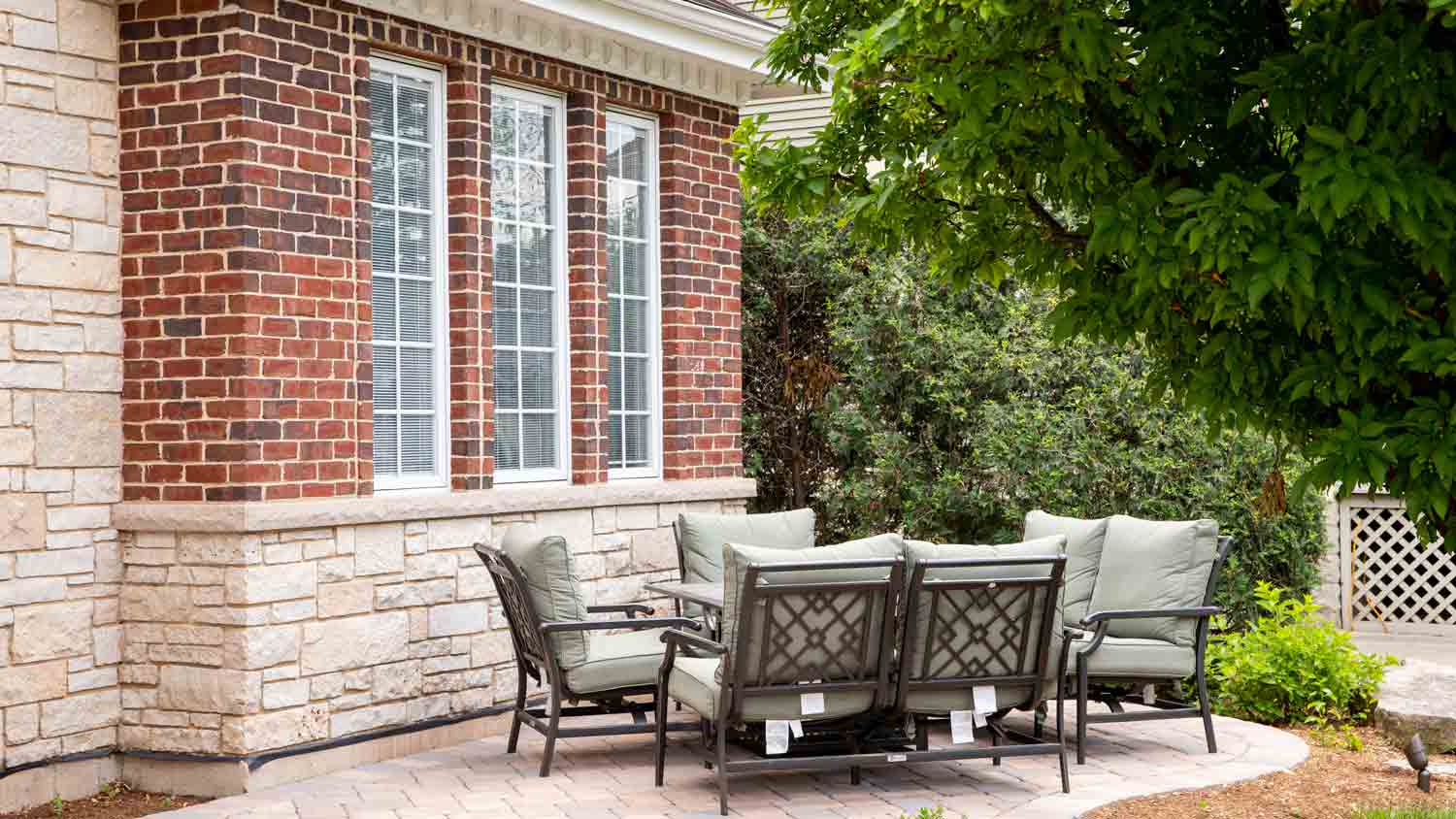
The cost to brick a house depends on several factors, like labor costs, home size, and brick types. Use our guide to estimate your bricking costs.
Here’s how to remove mortar stains without damaging your bricks


DIY mortar removal can cost between $300 and $500, while hiring a masonry pro averages to $10 to $20 per square foot for a quick, efficient job.
Homeowners may need brushes, chisels, protective gear, and acid-resistant supplies to complete the project on their own.
A licensed masonry expert is trained to avoid over-scrubbing, using too strong a chemical, or rushing the process, mistakes that can chip or discolor your bricks.
If you want to keep your bricks looking pristine, cleaning mortar off bricks needs to be on your to-do list. How do you clean mortar off bricks? While not complex, this task does require a mix of time and old-fashioned elbow grease. The payoff is that properly maintained mortar can last up to 100 years while looking beautiful. Follow along to learn what you need to know.
The reason why mortar removal is important is that mortar stains brickwork. As a result, your bricks can look sloppy. However, this is more than just an aesthetic concern. Displaced mortar can actually make brickwork insecure. Fortunately, you can remove mortar in just a few steps without the need for harsh chemicals.
The telltale sign that rogue mortar needs to be removed from your brickwork is that you're seeing smeared, splotchy stains around your bricks. This staining occurs because mortar dries rapidly following application. If mortar wasn't applied by an expert, there's a good chance that it will blur "outside the lines" of your bonded bricks. Of course, it's always wise to have a professional assess any worn-looking brick prior to investing in this project to get an opinion on whether you should repair vs. replace the bricks.
Start this project by preparing the surrounding area to establish a pristine and controlled work environment. Since a cleaning solution will be introduced later in the process for some methods, it's important to remove any objects that could be harmed by a cleaning product. Even excess mortar falling down can be harmful. If you have plants or landscaping in the trickle-down path of where you'll be cleaning, cover them with tarps. Tape all door frames and window sills with heavy-duty masking tape.
You can clean mortar off bricks using mechanical methods (brush or chisel), but there are also chemical solutions (muriatic acid or vinegar) to pair with the brush method that make it more effective. Below, we’ll walk you through how to clean mortar off bricks after it’s dried using all of these methods.
Note: We recommend wearing gloves for all methods and long sleeves, masks, and eye protection when working with certain chemicals.
Mechanical mortar removal involves water and some good, old-fashioned elbow grease (and maybe a cleaning solution, too). Here are two mechanical methods for cleaning stubborn mortar off your brick wall:
This method requires a heavy-duty fiber cleaning brush, which you can pick up at a hardware store for around $10. If you’re scrubbing a large area of brick, you may need more than one brush.
You’ll start by washing the surface (spraying with a garden hose is fine!), as water adds as a natural lubricant and barrier for brick—this is important when spreading the cleaning solution.
Next, you’ll apply a commercial cleaning solution. Check to see if it contains hydrochloric acid, though; this can leave your brick stained, especially if you leave it on for too long. (We’ll cover how to clean mortar off bricks with hydrochloric acid in the chemical removal section next.)
We recommend applying a little cleaner at a time, then scraping that area with the brush. Tough areas may require more cleaning solution as you scrub. Rinse the wall when you are finished.
If you don’t want to use a cleaning solution on your wall and are OK with some more grueling labor, you can turn to a hammer and chisel. In fact, scrub brushes are often not effective enough, so you may need to try a chisel even if you’ve brushed off most of the mortar but have one or two stubborn bits that won’t budge.
As with the brush method for removing mortar from bricks, you’ll want to start by wetting the brick with a garden hose. Then hold your chisel as parallel to the wall as possible, tapping downward with your hammer to chisel away the dried mortar. Start with light taps and only increase the intensity if the mortar isn’t coming off.
You may still want to follow up with some water and a brush after chiseling to remove the mortar entirely.
Some homeowners prefer not to use chemicals on their brick (or anywhere throughout their homes), but chemical removal is actually more effective for cleaning mortar off brick. Here are two chemical solutions to try.
Muriatic acid, also called hydrochloric acid, is a colorless, pungent, highly corrosive solution—and it’s also toxic. You absolutely must wear a mask, eye protection, and gloves when working with this solution. We also recommend long sleeves, pants, and closed-toe shoes. Make sure you have a box of baking soda in your work station—you’ll want to quickly pour it on yourself if your skin makes contact with the acid.
Here’s how to clean mortar off brick with hydrochloric acid:
Read the instructions on the bottle.
Dilute the acid with water (in an acid-resistant bucket). A 10-to-1 water-to-acid ratio is as strong as you should make it.
Spray the brick with water.
Use an acid-resistant brush to apply the muriatic acid to the brick. Start in one small area (one that’s generally hidden by a shrub or tree) to see how the brick reacts before applying it to a larger area.
Let the acid sit on the wall for 5 minutes. Once it starts to fizz, you know it’s doing its job.
Scrub the acid away with a brush.
Spray the wall with more water to thoroughly wash away the acid.
Note: Muriatic acid can damage or even stain brick if used incorrectly or too frequently—or left on too long. Only use muriatic acid if you’re comfortable working with the solution and have thoroughly read the bottle. If you’re not sure how to use it, consider calling a local brick repair company for assistance.
If vinegar is the strongest acid you’re comfortable working with, you can follow the same steps outlined above, but with multipurpose cleaning vinegar instead of the hydrochloric acid. You’ll still wet the brick, apply the vinegar with a brush, let it sit for a few minutes, and scrub it away.
However, vinegar is much less caustic than muriatic acid, so you don’t need to wear all the protective gear. However, this also means you may need to apply vinegar several times to get the mortar to come off, and you’ll need to scrub extra hard with the brush to see results.

If you've inherited a home with existing brick, it's impossible to go back in time to undo the poor workmanship that caused mortar stains. However, you can move forward in the right direction to ensure you don't have to tackle this project again in the future. Here are some tips to prevent mortar stains on brick:
If you've noticed damaged or cracked mortar during this project, use your chisel or brush to remove a tiny piece that you can bring to a local brick supplier or masonry store. This will allow you to repair the issue using mortar of the same type, color, and consistency.
When doing mortar work, always give mortar enough time to dry before attempting to wash your brick. It can take mortar a full month to cure in some cases.
Consider having all future brick installation or repairs at your home done by a licensed masonry or siding expert.
If you're wondering if DIY mortar removal will save you money, it's helpful to know that removing old, cracked mortar can cost between $300 and $500 on average. Most masonry experts charge between $10 to $20 per square foot when a project includes removal and some refilling. While mortar removal from brick can be a DIY job, the high risks for staining or weakening brick if the wrong products or techniques are used make this a job that's best left to licensed siding repair experts near you. If you live in an older property, there may be local or district-level laws regarding how historic brick restoration must be completed.
From average costs to expert advice, get all the answers you need to get your job done.

The cost to brick a house depends on several factors, like labor costs, home size, and brick types. Use our guide to estimate your bricking costs.

Discover the average stone restoration cost, including price ranges and key factors, to help you plan your next home project with confidence.

Door or window lintel replacement costs $400 on average, but there are ways you can save. On the other hand, complicated work will increase costs considerably.

Review this list of questions to ask when hiring a masonry contractor for home projects.

Discover the true stone patio cost to plan your budget. Learn about material, labor, and cost factors to estimate your project and make informed decisions.

Discover the common masonry problems that can harm stone or brick surfaces at your home. While some masonry issues can be fixed with DIY solutions, anything involving brick replacement should be done by a professional.